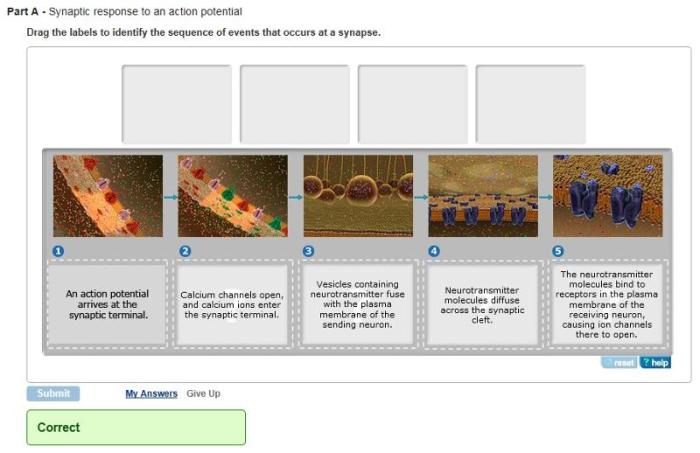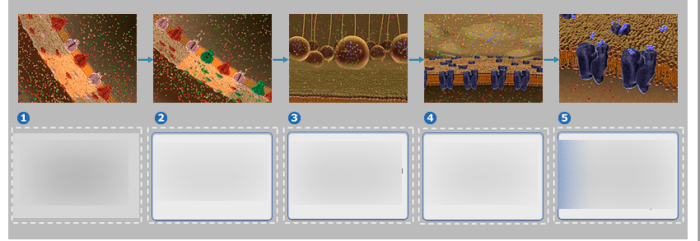Embark on a captivating journey with the Bioflix activity: How Synapses Work — Events at a Synapse. Prepare to unravel the intricate mechanisms underlying synaptic transmission, exploring the role of neurotransmitters and the fascinating concept of synaptic plasticity. This immersive activity promises a comprehensive understanding of synapses, their significance in neurotransmission, and their implications for neurological disorders.
Synapses, the fundamental units of communication between neurons, play a pivotal role in shaping our thoughts, emotions, and actions. This activity delves into the structural and functional aspects of synapses, examining the distinct types and their involvement in neurotransmission. We will explore the dynamic events that occur at a synapse, including the release, binding, and reuptake of neurotransmitters, and delve into the mechanisms that govern synaptic plasticity, the ability of synapses to modify their strength and efficacy over time.
1. Synapse Overview

Synapses are specialized junctions between neurons that allow for the transmission of electrical or chemical signals. They play a crucial role in neurotransmission, the process by which neurons communicate with each other and with target cells.
Synapses are composed of three main components: the presynaptic terminal, the synaptic cleft, and the postsynaptic terminal. The presynaptic terminal contains neurotransmitters, which are chemical messengers that are released into the synaptic cleft. The synaptic cleft is a narrow gap between the presynaptic and postsynaptic terminals.
The postsynaptic terminal contains receptors that bind to neurotransmitters and generate a response in the postsynaptic neuron.
There are two main types of synapses: chemical synapses and electrical synapses. Chemical synapses use neurotransmitters to transmit signals, while electrical synapses use ion channels to transmit signals. Chemical synapses are more common than electrical synapses.
2. Events at a Synapse

Synaptic transmission occurs in a series of steps:
- An action potential arrives at the presynaptic terminal.
- The action potential causes the release of neurotransmitters from the presynaptic terminal into the synaptic cleft.
- The neurotransmitters bind to receptors on the postsynaptic terminal.
- The binding of neurotransmitters to receptors causes the opening of ion channels in the postsynaptic terminal.
- The opening of ion channels allows ions to flow into or out of the postsynaptic terminal, which generates a postsynaptic potential.
The postsynaptic potential can be either excitatory or inhibitory. An excitatory postsynaptic potential (EPSP) makes it more likely that the postsynaptic neuron will fire an action potential. An inhibitory postsynaptic potential (IPSP) makes it less likely that the postsynaptic neuron will fire an action potential.
Synaptic plasticity is the ability of synapses to change their strength over time. Synaptic plasticity is thought to be the basis of learning and memory.
3. Bioflix Activity

The Bioflix activity on “How Synapses Work” provides a detailed overview of the structure and function of synapses. The activity includes animations, diagrams, and interactive exercises that help students to understand the key concepts of synaptic transmission.
The activity is an effective learning tool because it provides students with a clear and concise explanation of the complex topic of synaptic transmission. The animations and diagrams help students to visualize the process of synaptic transmission, and the interactive exercises help students to test their understanding of the material.
4. Synaptic Disorders

Synaptic dysfunction is thought to play a role in a number of neurological disorders, including Alzheimer’s disease, Parkinson’s disease, and schizophrenia.
In Alzheimer’s disease, the loss of synapses is thought to be a major factor in the cognitive decline that is characteristic of the disease. In Parkinson’s disease, the loss of synapses in the substantia nigra is thought to be responsible for the motor symptoms of the disease.
There are a number of potential treatments for synaptic disorders. These treatments include drugs that can improve synaptic function, and surgical procedures that can repair damaged synapses.
5. Future Directions: Bioflix Activity: How Synapses Work — Events At A Synapse
Research on synapses is ongoing, and there is a growing understanding of the role that synapses play in learning, memory, and neurological disorders.
One area of active research is the development of new drugs that can improve synaptic function. These drugs could be used to treat a variety of neurological disorders, including Alzheimer’s disease and Parkinson’s disease.
Another area of active research is the development of new surgical procedures that can repair damaged synapses. These procedures could be used to treat a variety of neurological disorders, including spinal cord injuries and stroke.
Answers to Common Questions
What is the significance of synapses in neurotransmission?
Synapses serve as the primary means of communication between neurons, enabling the transmission of electrical and chemical signals throughout the nervous system. They play a crucial role in processing information, forming memories, and regulating behavior.
How does synaptic plasticity contribute to learning and memory?
Synaptic plasticity allows synapses to strengthen or weaken over time in response to repeated activity. This dynamic property underlies learning and memory formation, as changes in synaptic strength represent the storage of information in the brain.
What are the potential implications of synaptic dysfunction in neurological disorders?
Synaptic dysfunction has been implicated in a wide range of neurological disorders, including Alzheimer’s disease, Parkinson’s disease, and autism spectrum disorder. Understanding the mechanisms underlying synaptic dysfunction is crucial for developing effective treatments for these debilitating conditions.